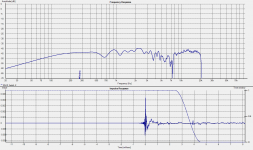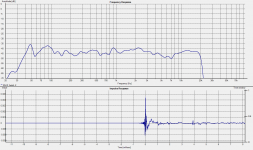Do you have level controls on the crossovers? Simply turning the tweeter down a bit could help. And titanium can have nasty breakup modes, that may be what you are hearing.The only "minor" issue is that they are a little bit sharp in high region.
Better to control tweeter resonance Pano , damping helps but may mush up everything . i would like to see impedance magnitude , the ringing should be present here and he can control from xover ...
Sorry I'm a noob in using HOLMImpulse, where do you get the cursor and how to set the delay from the 1st impulse?
I found this link very helpful:Sorry I'm a noob in using HOLMImpulse, where do you get the cursor and how to set the delay from the 1st impulse?
A HOLM starter guide
A HOLM starter guide
I have L-pads, and they help a bit, but not quite.Do you have level controls on the crossovers? Simply turning the tweeter down a bit could help. And titanium can have nasty breakup modes, that may be what you are hearing.
I heard Greg Timbres have said, coating the dome of these Ti tweeters, removes the "zing" out of them and should tame them.Better to control tweeter resonance Pano , damping helps but may mush up everything . i would like to see impedance magnitude , the ringing should be present here and he can control from xover ...
See here:
https://www.google.ca/search?q=JBL+...woH4Aw&ved=0CAkQ_AUoAQ&biw=1097&bih=581&dpr=1
How can I measure the impedance magnitude?
To me the midrange looks hot and then you have some trouble around 7.5K. Wonder if that is driver or crossover related? Guess the only way to tell is now to measure the drivers solo.OK. I brought the speaker in the middle of the room. And this is the response I got!!!
Thanks for doing all the work and posting here! We'll figure out something yet. 🙂
Oh, one more thing. I see a lot of hard surfaces. Bare walls, fireplace, wood floor. The wood and brick can sound OK, but in combination with the bare walls may lead to a harshness you are hearing. I had to treat my walls like crazy to avoid that. Still have a little ring left.
Thanks, HOLM looks much easier to use compared to ARTA.
This is what I got from ARTA using Near-Field(LF Diffraction), Far-Field and then combine them. I see if I can get the same results with HOLM, and figure out if my ARTA's jig can be used on it.
An externally hosted image should be here but it was not working when we last tested it.
Last edited:
You'll probably need some dedicated hardware to do that. Either a woofer tester or a jig to use with software. The impedance can be plotted by hand, but it's tedious.How can I measure the impedance magnitude?
I have to thank you for the help. 🙂Thanks for doing all the work and posting here! We'll figure out something yet. 🙂
I totally agree. How do you suggest I treat the walls?Oh, one more thing. I see a lot of hard surfaces. Bare walls, fireplace, wood floor. The wood and brick can sound OK, but in combination with the bare walls may lead to a harshness you are hearing. I had to treat my walls like crazy to avoid that. Still have a little ring left.
Can't one simply use the factory measurements?You'll probably need some dedicated hardware to do that. Either a woofer tester or a jig to use with software. The impedance can be plotted by hand, but it's tedious.
Last edited:
- Status
- Not open for further replies.
- Home
- Loudspeakers
- Multi-Way
- Measuring the SPL of loudspeaker at home.


![IMG_0530[1].png](/community/data/attachments/333/333722-821e6c67af5914b5bca7275fc47bbd37.jpg?hash=gh5sZ69ZFL)